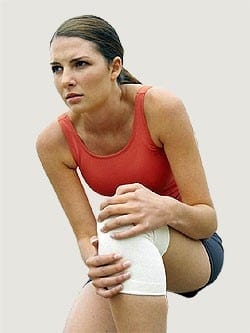- Knee injuries range in severity and include bruising and grazes, muscle tears, ligament and tendon damage, meniscus damage, cartilage problems, synovial fluid issues and joint dislocation.
- The “RICE” method should be followed when administering first aid to sports-related injuries:
- “MIPO” (minimally invasive plate osteosynthesis), this method reduces the impact on the surrounding muscles tissue and enables the bones affected to fuse at a faster rate than would be possible through other forms of surgical treatment.
What You Should Know About Sports-Related Knee Problems
Modern-day lifestyles, especially for those living in large cities, are often hurried and full of competition, which can lead to stress for both body and mind. Sport and exercise therefore play a key role in restoring our mental and physical well-being, so that we are able to return to work and our daily lives feeling refreshed.

Playing sport is a form of rest and relaxation that can also help support our various bodily functions by building muscle strength at the same time as stimulating the body’s cardiovascular and circulatory systems. Exercising requires the body to transport blood that contains oxygen and chemicals to cells all over the body. In addition, exercising leads the brain to produce more chemicals called endorphins. These are chemicals that are responsible for the feeling of happiness and so improve our mental well-being.
There are numerous sports that are currently popular, including golf, tennis, badminton and football. Selecting the sport to play depends entirely on the individual’s preferences and physical capabilities.
Tennis is one of the most popular sports, as it can be played by anyone of any age and gender, and it is also a relatively safe sport. Injuries, however, can occur due to the various aspects required to play, such as running, fast changes of direction and sudden stops. Injuries that can be sustained while playing tennis include cuts, grazes, bruising, torn ligaments and even bone fractures.
Injuries can be prevented by sustaining fitness and health, by being aware of the various techniques involved, by practicing the appropriate skills required, as well as by stretching and warming up/down before and after every session.
The “RICE” method should be followed when administering first aid to sports-related injuries:
- Rest Take a break from the sport or stop playing it immediately in order to avoid further injury.
- Ice Apply ice to the affected area. This causes the blood vessels to constrict and will reduce pain, inflammation and bleeding.
- Compression Applying pressure or wrapping up the injured area will reduce inflammation, stop hemorrhage and reduce swelling.
- Elevation Raising the injured area above your heart will reduce local blood vessel pressure and increase drainage of the flow to the affected area, which significantly reduces bleeding and swelling.
The area of the body which is frequently injured and requires medical treatment is the knee joint. Knee injuries range in severity and include bruising and grazes, muscle tears, ligament and tendon damage, meniscus damage, cartilage problems, synovial fluid issues and joint dislocation.
Treatments depend on the severity of the injury, with less severe injuries being treatable through the “RICE” method. However, if the injury takes longer than 2-3 days to go away, a visit to the doctor for a detailed diagnosis and subsequent treatment advice is required.

A visit to the doctor will include a detailed study of the patient’s medical and injury history, as well as a full body checkup. In some cases, a more thorough evaluation may be required so an X-ray may be carried out to assess whether there are any bone fractures, or an MRI scan may be undertaken to assess any muscle, ligament, tendon, meniscus or cartilage damage.
Less severe injuries may only require oral medication, such as pain relief medicine, anti-inflammatory medicine or medication that can be applied to a specific area of the body. However, if the injury sustained is a form of torn ligament or bone fracture, a cast may be necessary. Alternatively, more serious injuries may require surgery. These may include torn ligaments, synovial fluid issues and cartilage damage, all of which can currently be treated through arthroscopic surgery, a form of surgery that causes minimal pain and scarring to the patient.
Benefits of arthroscopic surgery:
- Minimal incision area that leaves the surrounding muscle tissue unharmed
- Minimal pain
- Low risk of complications
- Reduces the time required for the patient to be hospitalized
- Enables a quick return to daily life
For injuries such as displaced fractures, bone fractures and intra-articular fractures, the surgical insertion of a metal implant is required in order to stabilize and reconnect the bones involved. Much progress has been made recently in terms of the material, design and implants used in this type of surgery. One such technique is referred to as “MIPO” (minimally invasive plate osteosynthesis). This method reduces the impact on the surrounding muscles tissue and enables the bones affected to fuse at a faster rate than would be possible through other forms of surgical treatment.
Sport is an extremely beneficial use of free time that has a positive effect on our mental and physical well-being. It can help us to relieve the stress we accumulate in our daily lives, thus providing us with more happiness and improving our quality of life. It is important, however, to take care of our physical health and treat injuries appropriately to ensure that we can continue to enjoy our favorite sports for as long as possible.
Related
articles